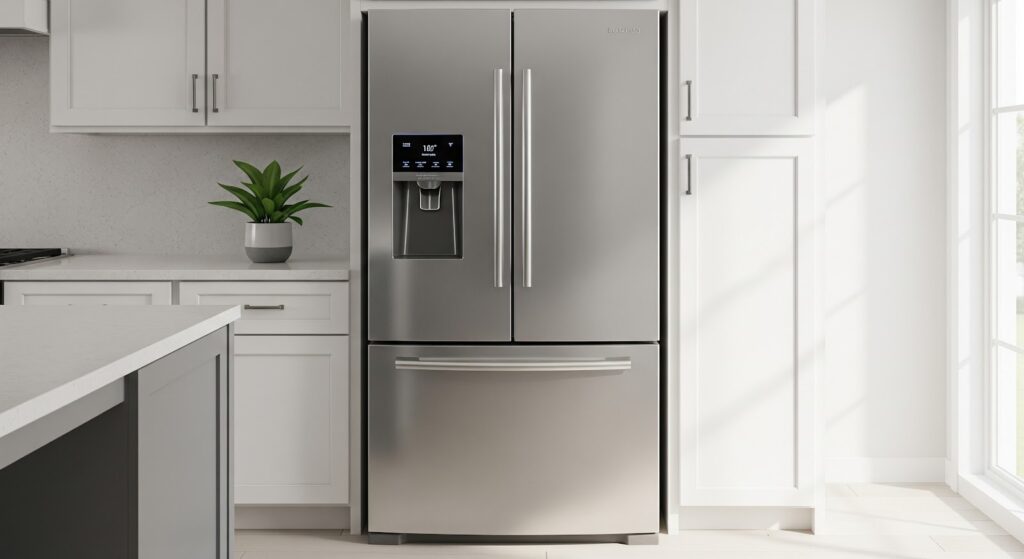
When your LG refrigerator stops keeping things cool, a faulty compressor start relay could be the reason. The good news is that you might not need to call a repair technician. This is a repair you can do yourself.
What the Compressor Start Relay Does
The compressor start relay helps the compressor start by powering the start winding on and off. When it fails, the fridge may not start properly or may stop cooling altogether. Replacing it is often all you need to get your refrigerator running smoothly again.
Tools and Parts You Will Need
- 1/2-inch wrench
- Phillips screwdriver
- Flathead screwdriver
- Towel
- New compressor start relay (make sure it is the OEM part for your fridge model)
Confirm Part Compatibility
Before buying a new relay, make sure it is the correct one for your refrigerator.
- Locate your fridge’s model number. It usually starts with “MOD” or “Model” and can be found:
- Inside the fridge on the side wall or ceiling
- On the back near the bottom
- On the side or bottom of the door
- Write the number down or take a photo so you have it when ordering the part.
Safety First
Whenever you work on an appliance, safety comes first. Here is what to do before starting:
- Turn off power by unplugging the refrigerator or switching off the circuit breaker.
- Allow it to cool if it has been running to avoid burns.
- Shut off the water supply if your fridge has a water line. Keep a towel nearby for drips.
- Clear the workspace so it is well lit and free of clutter, pets, and children.
- Keep hands dry and the work area free from water.
- Wear insulated work gloves to protect against sharp metal edges.
- Handle parts gently to avoid damage or injury.
- Avoid touching exposed wires or terminals. Use a non-conductive tool or insulated gloves if necessary.
- Take photos of wiring before disconnecting anything to make reassembly easier.
How to Replace the Compressor Start Relay on an LG Refrigerator
Here are the steps to safely remove the old compressor start relay and install a new one.
Disconnect Power and Water
- Unplug the refrigerator from the power outlet and disconnect it from the water supply.
- Place a towel under the water inlet hose to catch any remaining water.
Remove Water Inlet Hose and Rear Access Panel
- Use a 1/2-inch open-end wrench to unscrew the water inlet hose from the rear access panel and set the hose aside.
- Use a Phillips screwdriver to remove the screws securing the rear access panel.
- Lift the panel to release the bottom tabs and remove the panel.
Access the Compressor and Start Relay
- Locate the cover box in the left rear corner of the refrigerator.
- Use a Phillips screwdriver to remove the single screw securing the cover box.
- Use a flathead screwdriver to carefully pry the cover off, releasing the bottom tabs and the top latch.
Remove Old Start Relay
- Insert a flathead screwdriver to carefully pry the old start relay off the compressor terminals.
- Disconnect the terminals and wires from the old relay.
Install New Start Relay
- Align the new start relay with the compressor terminals, with the flat part and post and pin positioned over the terminals.
- Install the new relay onto the compressor terminals and reconnect the wires.
Reassemble Components
- Slide the cover back on so the bottom cutout allows the harness to pass through.
- Secure the cover box with the single Phillips screw.
- Reinstall the rear access panel by aligning the clips with the tabs and securing it with Phillips screws.
- Reconnect the water inlet hose to the refrigerator by hand-tightening, then snugging it with a 1/2-inch open-end wrench without overtightening.
Restore Power and Water
- Plug the refrigerator back into the power outlet and reconnect it to the water supply.
Preventing Future Relay Problems
Replacing the relay fixes the current issue, but maintenance habits can help extend its life:
- Keep the condenser coils clean to reduce strain on the compressor
- Maintain proper airflow around the refrigerator by leaving space between the back and the wall
- Avoid overloading the fridge with heavy or dense food items that block airflow
- Regularly check door seals for tight closure to prevent excess compressor cycling
- Use a surge protector to protect electrical components from voltage spikes
- Keep the appliance level to avoid vibration stress on internal components
- Defrost the freezer if frost buildup becomes excessive
The Bottom Line
Your LG fridge can be back to cooling like it should with just a bit of time, the right tools, and some patience. Swapping out a faulty start relay is a straightforward fix that can save you both money and hassle. With the steps above, you now know how to identify the problem, work safely, and put everything back together the right way. Taking care of your refrigerator after the repair, like keeping the coils clean and avoiding overloading it, will help keep it running well for years. Sometimes a small repair makes all the difference in keeping your kitchen running smoothly.
